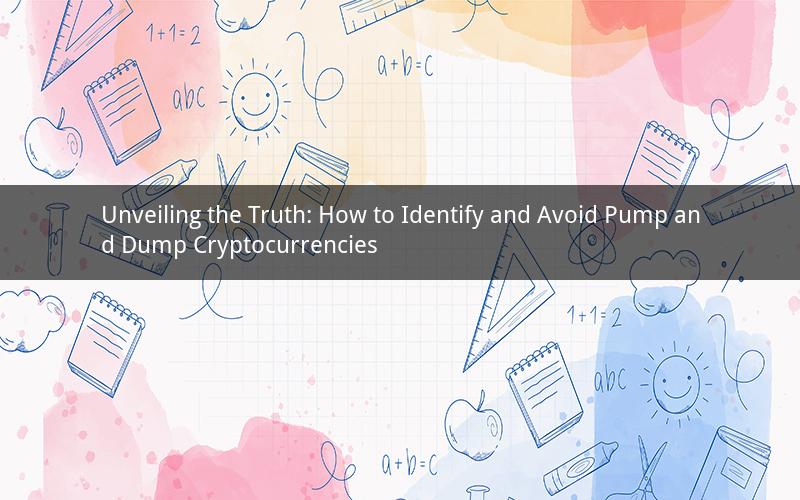
Introduction:
Pump and dump schemes have been a persistent issue in the cryptocurrency market. These fraudulent activities involve manipulating the price of a cryptocurrency by artificially inflating it, followed by selling off the assets at a profit. As a result, unsuspecting investors often suffer significant losses. This article aims to provide an in-depth understanding of how to identify pump and dump cryptocurrencies and protect yourself from falling victim to these schemes.
1. Understanding the Basics of Pump and Dump Schemes
To effectively identify pump and dump cryptocurrencies, it is crucial to understand the basic principles behind these schemes. In a typical pump and dump scenario, a group of individuals colludes to drive up the price of a cryptocurrency through coordinated buying and selling activities. Once the price reaches a predetermined level, they quickly sell off their assets, causing the price to plummet.
2. Analyzing Price Volatility
One of the primary indicators of a potential pump and dump cryptocurrency is its high price volatility. If a cryptocurrency experiences extreme price swings within a short period, it may be a sign of manipulative activities. Analyzing the historical price charts can help identify patterns and trends that suggest pump and dump schemes.
3. Examining Trading Volume
Trading volume is another critical factor to consider. In a pump and dump scenario, a significant increase in trading volume is observed during the pump phase. However, after the dump, trading volume tends to decline sharply. By comparing trading volume patterns, you can identify potential manipulation and avoid participating in fraudulent activities.
4. Identifying Red Flags
There are several red flags that can help identify pump and dump cryptocurrencies. Some common indicators include:
a. Unusually high social media activity: If a cryptocurrency suddenly gains significant attention on social media platforms without a plausible explanation, it may be a sign of a pump and dump scheme.
b. Absence of credible news or developments: Cryptocurrencies that experience sudden spikes in price without any substantial news or developments behind them are more likely to be involved in pump and dump activities.
c. Pump and dump forums: Online forums dedicated to discussing pump and dump schemes can provide valuable insights into potential fraudulent activities. Pay attention to discussions and warnings about specific cryptocurrencies.
5. Conducting Due Diligence
Before investing in any cryptocurrency, it is essential to conduct thorough due diligence. This includes researching the project's team, technology, market potential, and community support. A cryptocurrency involved in pump and dump schemes often lacks a strong foundation and reputable team.
6. Utilizing Technical Analysis
Technical analysis involves analyzing historical price and volume data to predict future price movements. By utilizing various technical indicators and chart patterns, you can identify potential manipulation and avoid participating in pump and dump schemes.
7. Setting Realistic Expectations
It is crucial to maintain realistic expectations when investing in cryptocurrencies. Avoid falling prey to unrealistic promises of massive returns. High-risk investments often come with high volatility, and it is essential to understand the potential consequences.
8. Protecting Yourself from Pump and Dump Schemes
To protect yourself from pump and dump schemes, consider the following measures:
a. Diversify your portfolio: Avoid investing a significant portion of your funds in a single cryptocurrency. Diversification can help mitigate the risks associated with pump and dump schemes.
b. Stay informed: Keep yourself updated with the latest market trends, news, and developments. This will enable you to make informed decisions and avoid falling victim to fraudulent activities.
c. Use reputable exchanges: Trade on well-established and regulated cryptocurrency exchanges. These platforms offer better security measures and are less susceptible to pump and dump schemes.
9. Reporting Suspected Fraud
If you come across a cryptocurrency that you suspect is involved in pump and dump activities, report it to the relevant authorities. This can help protect other investors and contribute to the overall integrity of the cryptocurrency market.
Conclusion:
Identifying pump and dump cryptocurrencies requires a combination of research, analysis, and vigilance. By understanding the basics of these schemes, analyzing price volatility and trading volume, and utilizing technical analysis, you can protect yourself from falling victim to fraudulent activities. Stay informed, maintain realistic expectations, and report any suspected fraud to contribute to a healthier and more transparent cryptocurrency market.
Questions and Answers:
1. What is the primary objective of a pump and dump scheme?
Answer: The primary objective of a pump and dump scheme is to artificially inflate the price of a cryptocurrency, allowing the organizers to sell off their assets at a profit before the price crashes.
2. Can pump and dump schemes be identified through social media activity?
Answer: Yes, unusual spikes in social media activity without any substantial news or developments can be a red flag for pump and dump schemes.
3. How can technical analysis help identify pump and dump cryptocurrencies?
Answer: Technical analysis can help identify patterns and trends in price and volume data, suggesting potential manipulation and alerting investors to potential pump and dump schemes.
4. What measures can investors take to protect themselves from pump and dump schemes?
Answer: Investors can protect themselves by diversifying their portfolios, staying informed, using reputable exchanges, and conducting thorough due diligence on the projects they are considering investing in.
5. How can suspected pump and dump schemes be reported?
Answer: Suspected pump and dump schemes can be reported to the relevant authorities, such as financial regulatory agencies or cryptocurrency exchanges, to help protect other investors and contribute to the overall integrity of the market.